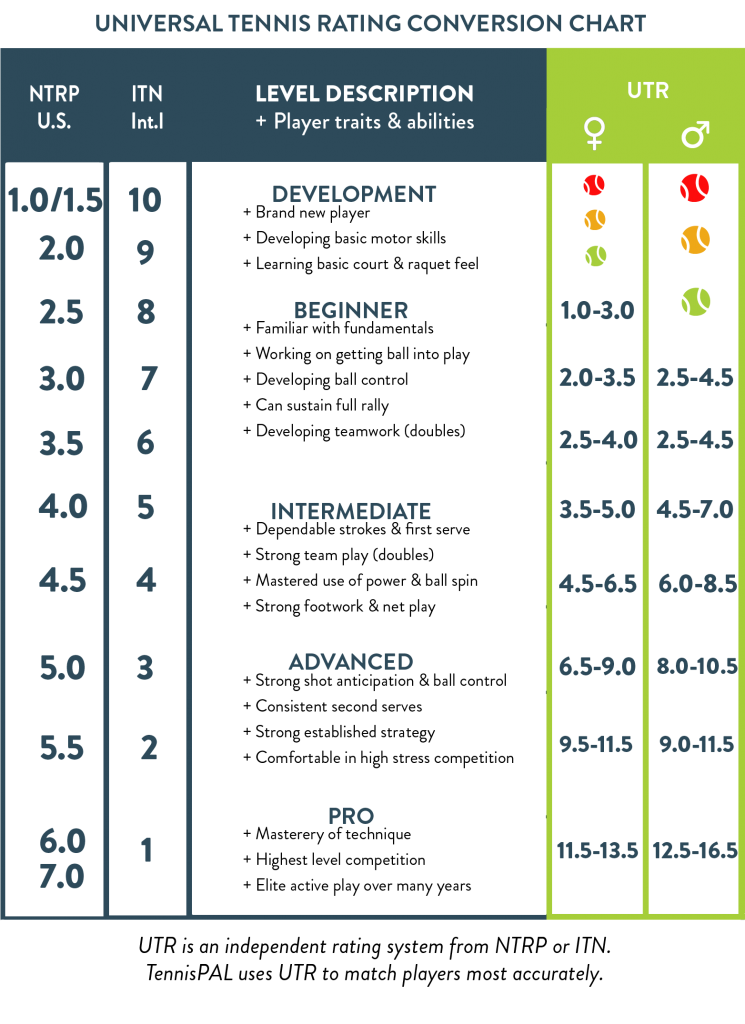UTR Tennis: What it is, why you want one & how to improve it {newbie friendly}
Play Locally. Count Globally
Universal Tennis, UTR Rating System
When you're getting started in tennis, the goal is to have fun, obviously! The more you like it, the more you want from it. Enter the world of tennis competition, where things get a little fuzzy. Especially if you have a young player and you as the parent, don’t play tennis. It’s a complex world you’ll need to figure out. And Universal Tennis' UTR rating system is where you’ll want to start. A popular rating system that brings the tennis world together and levels the playing field of competition for both juniors and adult tennis.
The UTR rating system, developed by Universal Tennis, is a system that promotes fair and competitive play across the tennis world. Based on the strength of your opponent, games won and a players last 30 matches any player can know their true tennis ranking.
If you’re new to tennis competition as a junior or adult, this should help you fully understand the pros and cons of having a UTR rating.
To keep it simple. Imagine a new junior player, we’ll call her “Susie”. Little Susie is entering 12 & under tournaments in the USA for the first time. Her parents aren’t tennis parents and have no idea how this UTR rating system works. They just want little Susie happy and playing because she shows talent and wants to compete.
We sat down with Stephen Armitraj, Universal Tennis’, Chief Tennis Officer and had him walk little Susie’s parents through the UTR system. Understanding what it is and how it helps makes the tennis world less confusing. And it’s really very simple to get started. Remember! This applies for junior and adults.
Pro tip: 💡
Adult tennis camps by playing level & travel destination in Summer 2023 check here.
Junior tennis camps year round check here.
How would you explain to little Susie’s father why she should get started with a UTR Rating?
The UTR rating system, developed by Universal Tennis, is a system that promotes fair and competitive play across the tennis world. All players from beginners to top pros like Serena Williams and Rafael Nadal are rated on the same scale from 1.00-16.50. Over 2.5 million players have a UTR Rating and over 20 million match results have been counted.
Before UTR Rating, players of all ages and levels had no idea where they fit on a global scale. By comparison, golf had a handicap system where just by knowing a player’s handicap, you could know their level.
So, knowing Susie’s UTR Rating will help her know what level she is at. It will also help her get into tournaments that are the appropriate competition level for her to improve her game, enjoy the competition, and work on her UTR Rating. By competing against players that are similar or better than her, Susie will be able to improve and be motivated to keep playing and have more fun.
If Susie is interested in college tennis, her UTR Rating will become very important. UTR Rating is the gold standard rating system for college recruitment in the U.S. Just like with SAT scores for academics, coaches rely heavily on UTR Rating to recruit players that will fit their roster’s level the best.
Learn more about UTR Rating here
Can Susie enter only UTR Tournaments to get this rating?
No, the UTR Rating algorithm takes into consideration all verified matches, including national, international (ITF juniors, ITF pros, etc), adult (club-level, organized leagues, and open tournaments), and professional (ITF, UTR Pro Tennis Tour, WTA/ATP).
See all events that count toward UTR Rating
Learn more about Verified vs. Non-Verified events and ratings
How does a UTR Rating compare with an NTRP Rating?
NTRP-ITN-UTR Rating Conversion
UTR Rating is the most accurate and comprehensive reflection of Susie’s level because it includes results across all categories (junior, college, open, pro, etc.) and geographic regions (Europe, the U.S., etc.). It takes into account who she played against (based on their UTR Rating) and how many games she won (not just if she won or lost). Since UTR Rating only factors in Susie’s last 30 eligible matches in the past 12 months, it’s the most accurate measure of where her skill level is right now.
See more about how UTR Rating is calculated here.
How does the rating scale work? How would little Susie know if she had a good UTR number?
All players, regardless of age, gender, geography, or skill level, are rated on the same scale between 1.00 and 16.50 based on actual match results.
Susie’s UTR Rating is calculated by an algorithm that uses her last 30 eligible matches in the past 12 months. (If she’s not a frequent competitor, she can still have a reliable UTR Rating; the platform can accurately assess her level based upon approximately five Verified UTR Rating matches.)
The first factor for each of Susie’s eligible matches is the UTR Rating difference between opponents. The second factor is the competitiveness of the match, as determined by the percent of total games won.
Given that Susie is just starting to play 12 and under tennis, she’ll look to be in the 2.00-3.00 UTR Rating range.
How could little Susie increase her UTR Rating within a year?
Susie can improve her UTR Rating by playing in Verified matches, which for her age and level over the next few years could include:
Federation sanctioned junior matches
ITF junior matches
Official high school team matches and tournaments
Sanctioned adult league and tournament matches (USTA, etc.)
Universal Tennis Verified Events run on our platform
See more about what counts as UTR Verified matches here
See some common junior tennis myths get demystified here
Learning how to play tennis check here
How do UTR tournaments work?
Universal Tennis tournaments are wide-ranging and include any events that are run on the platform. Providers (meaning whoever is hosting the event) are in charge of choosing dates, format, draw size, eligible players, level, etc.
Universal Tennis tournaments can be one-day, short-set round-robin events, week-long knockout tournaments, six-week-long leagues, etc. Events are college, junior, pro, adult, open, co-ed, singles, doubles, and more.
Is there an app little Susie’s Dad can easily check her UTR Rating? How often is it updated?
We have an iOS mobile app available in the United States and Australia, and our website is www.universaltennis.com. UTR Ratings are updated every 24 hours.
How long will it take little Susie to get a UTR Rating? How many matches does she need in order to have verified UTR?
One match result is all it takes to receive a projected UTR Rating. After approximately five matches, her rating becomes fully reliable. As she plays more matches, her UTR will increase or decrease over time.
How much can you improve your UTR Rating in one year?
Improving your UTR Rating takes competing hard, playing a lot of matches, and having patience. In the case of Susie, improving from a 2.00 to 3.00 could be accomplished in one year.
Does High School Tennis count towards your UTR Rating?
Yes, official high school team matches and tournaments count. Tournaments/matches must be organized by verified third parties or Universal Tennis.
Do Adult Tennis leagues count towards UTR Rating?
Adult tennis camp event- indieTENIS
Yes, sanctioned adult league and tournament matches (USTA, etc.) Tournaments/matches must be organized by verified third parties or Universal Tennis.
How can Adults apply tennis UTR?
Just like little Susie and other juniors, adults can benefit from knowing their UTR Rating and finding level-based play. With an accurate UTR Rating, players can find out what events/tournaments/leagues make sense for their level, be seeded and grouped appropriately, and find the right hitting partner or doubles partner. By paying attention to their UTR Rating over time, they can see if they are improving.
How important is a UTR Rating?
UTR Rating is important for players of all levels, genders, and geographic locations to find out their tennis “handicap” and benefit from level-based play.
Players benefit from UTR Rating by knowing their level for finding hitting partners, tournaments, leagues, colleges, camps, teams, and more. Providers benefit from UTR Rating by knowing which players to accept and seed in a draw, which players to group together for round-robin or group play, which players would be the right fit for a team/camp, and more.
Any pros and cons of UTR Rating?
The pros are well covered in the answers above. The cons would be that focusing heavily on a number, even one as accurate as UTR Rating, isn’t recommended, especially for young players like Susie. Her UTR Rating will improve as she plays more and she shouldn’t obsess over it.
Instead, Susie should focus on:
Playing Well – Performing well in matches is the easiest way to improve your UTR Rating. If the match is out of hand, don’t give up! It does not matter whether you play higher- or lower-rated opponents; you can improve your UTR either way by winning more games than expected.
Playing Often – The more matches you play, the quicker your UTR Rating will reflect your current form. The algorithm is especially accurate for those who play often against a variety of opponents rated above and below you.
Being Patient – Since your UTR Rating is a rolling weighted average, the effect of new results is slightly lagged. Your UTR Rating may not fully reflect a recent outcome right away, but it will over time.
Why do I here rumblings around the UTR Rating being a flawed system?
No rating system will ever be perfect in everyone’s eyes and some people will find fault in each system. But UTR Rating is the most accurate, comprehensive, and up-to-date tennis rating in the world. There is no bias or influence on the algorithm. UTR Rating is based on facts: your most recent results, the level of the player you’re competing against, and how well you did (games won).
In which case would my UTR Rating not count?
If you’re playing a casual match that is not organized by a verified, sanctioned third-party or Universal Tennis, the match won’t count towards your Verified UTR Rating.
The algorithm also excludes matches in which a) a player withdraws before the match starts, b) the match starts but neither player wins at least four games (due to a withdrawal/retirement), or c) there is a UTR Rating difference of more than 2.00 and the higher-rated player wins as expected. These excluded matches still show up on the player profile but are not used in the rating calculation.
Learn more about the algorithm here
With love from Mallorca~




